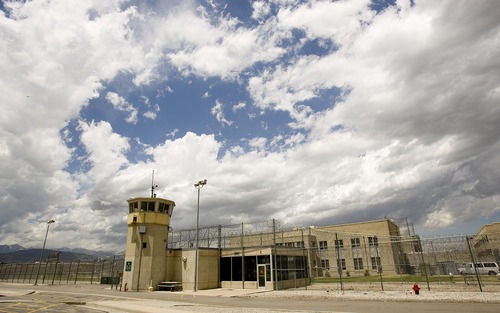This is an archived article that was published on sltrib.com in 2013, and information in the article may be outdated. It is provided only for personal research purposes and may not be reprinted.
Increasing prison populations, aging inmates and rising medical costs are causing states, including Utah, to devote a growing portion of tax dollars to health care services for incarcerated individuals.
Utah is one of four states — the others are California, New Hampshire and Arkansas — where inmate health care spending shot up by 100 percent from 2001 to 2008, according to a report released Tuesday by The Pew Charitable Trusts and the MacArthur Foundation. In another eight states, expenses rose 90 percent.
Nationally, prison health care expenditures were the second fastest-growing part — Medicaid is first — of state health care spending during the past two decades, the analysis found. The report compares prison health care data from the U.S. Bureau of Justice Statistics for 44 states in the years 2001 and 2008, the most recent figures available.
In 2008, the 44 states spent $6.5 billion on prison health care out of $36.8 billion in overall correctional expenditures, the analysis found. Only two states — Texas and Illinois — had spending decreases.
During that period, per-inmate health care spending rose 72 percent in Utah, ranking it 11th among the 44 states for which data were available. Utah's total prison medical costs have jumped from $9.9 million in 2001 to $21 million in 2008, according to the report, a 113 percent leap. Between 2001 and 2008, only three states experienced a larger percentage increase in the slice of total corrections budget devoted to health care than Utah did.
That said, Utah's per inmate annual medical cost is lower than that of many states.
But a recent state audit of the Utah Department of Corrections found annual per-inmate medical costs had increased an additional 25 percent since 2008. The department currently has a health care budget of $28 million.
Rising health care costs have partly tracked increases in prison populations, Pew said. The number of people incarcerated in state prisons grew 15 percent to 1.5 million between 2001 and 2008. The report said that was due in part to get-tough sentencing laws, strict probation and parole policies and longer prison terms. There are currently about 7,100 inmates in Utah's two state prisons.
But growth in prison populations alone does not explain why states are spending more on inmate health care, said Maria Schiff, director of the state health care spending project, which conducted the study for the two nonprofit organizations.
Other factors include aging inmates; prevalence of infectious and chronic diseases, including hepatitis C and AIDS, among inmates; high rates of mental illness and substance abuse among inmates; and challenges inherent in providing prison health care, such as having to transport inmates to hospitals and other treatment facilities.
Since 1984, the number of inmates nationally who are age 55 or older has more than quadrupled and about a third are ineligible for parole. Another trend: an increase in offenders who are age 55 or older when they are first admitted to prison.
Offenders typically experience age-related problems sooner than the general population due to such factors as lack of access to preventative health care prior to incarceration and substance abuse and mental-health issues.
About three years ago, Utah opened a special geriatric unit at the Utah State Prison to house aging inmates. About 9 percent of the state's total prison population is older than 55. The department estimates health care costs of those inmates are 12 times more expensive than those of younger inmates.
Schiff said some states have been able to reduce costs with initiatives that include use of telemedicine (video-conferencing with inmates, who remain at the prison); better management of off-site provider contracts; Medicaid enrollment of inmates who receive treatment outside prison for at least 24 hours; and expanded use of compassionate releases for terminally ill and geriatric offenders.
Among examples of how other states are reducing costs:
• Texas is estimated to have saved $780 million on inmate health care costs between 1994 and 2008 using telehealth services; in fiscal 2012 Texas used telehealth around 84,000 times, mostly for psychiatric and primary care services.
• New York estimates Medicaid reimbursements totaled $4.5 million as if December 2012; Ohio estimates it will save $273 million on prison health care costs between 2014 and 2022 by adopting expanded Medicaid criteria available under the Affordable Care Act.
• Under its compassionate-release guidelines, California had released 47 inmates who were in comas, had extensive brain damage or severe Alzheimer's disease or terminal illnesses as of October 2012, saving an estimated sum that exceeded $20 million.
But Schiff cautioned there is no one-size-fits-all solution to states' prison health care challenges.
In the past year, Utah also has pursued Medicaid coverage for inmates who received care at University Hospital, receiving $1.4 million in federal reimbursements. The state also has implemented several measures identified in the Pew report as ways to reduce inmate health care costs. It increasingly relies on telemedicine services for some diagnostic evaluations, for example.
But the recent audit of Utah's correctional system said the departmentcould pare medical expenses by as much as $500,000 annually by negotiating a less-expensive contract with an off-site medical provider; seeking lower cost prescription drugs; and moving to an automated claims system.
The department has not sought competitive bids to provide its off-site health care contract, currently held by University of Utah Health Care, since 1992 and its rates were 49 percent higher than another local provider's rates, the audit found. The department also pays as much as 800 percent more for some prescription drugs.
In response to the audit, the department said it plans to rebid its off-site health care contract at the end of the fiscal year, when the current contract expires. However, department officials said in the past that other providers have not been interested in the contract.
Twitter: @Brooke4Trib







